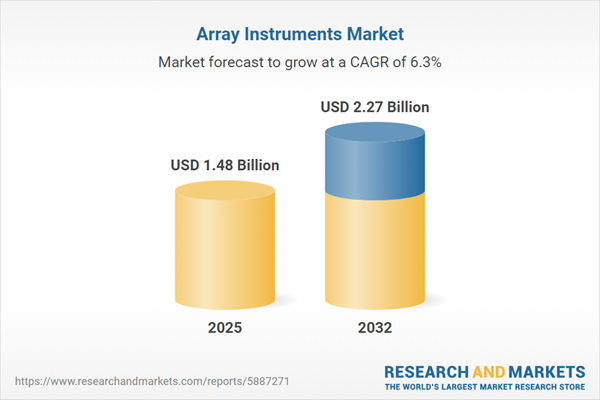Speak directly to the analyst to clarify any post sales queries you may have.
The Array Instruments Market is poised for significant transformation as life sciences research and clinical diagnostics expand their reliance on high-throughput, data-rich platforms. Driven by innovation in detection and analytics, and shaped by a rapidly evolving global environment, this market offers a distinct opportunity for manufacturers and stakeholders to realign their strategies and capture new value.
Market Snapshot: Array Instruments Market Size & Growth
The Array Instruments Market grew from USD 1.39 billion in 2024 to USD 1.48 billion in 2025. It is expected to continue growing at a CAGR of 6.30%, reaching USD 2.27 billion by 2032. This upward trend is fueled by increasing demand for advanced analysis tools in genomics and diagnostics, an expanding applications portfolio, and sector-wide investments in technology infrastructure.
Scope & Segmentation: Strategic Overview
This report maps comprehensive segmentation and regional coverage to support investment and operational decisions:
- Product Type: Consumables (including reagents and slides), Systems (such as readers and scanners)
- Technology: cDNA arrays (multi-color, single-color), Oligonucleotide arrays (in situ synthesis, spotted arrays), Protein arrays (label-based, label-free), Two-color arrays
- Application: Diagnostics (cancer diagnostics, genetic testing, infectious disease diagnostics), Drug discovery, Genomics, Proteomics
- End User: Academic research organizations, Biotechnology companies, Clinical laboratories, Pharmaceutical companies
- Distribution Channel: Direct sales, Distributors (system integrators, value-added resellers), Online sales channels
- Regional Coverage: Americas (including North America and Latin America), Europe, Middle East & Africa, Asia-Pacific (covering key growth markets such as China, India, and Japan)
- Key Companies: Thermo Fisher Scientific Inc., Illumina, Inc., Agilent Technologies, Inc., F. Hoffmann-La Roche AG, Danaher Corporation, Bio-Rad Laboratories, Inc., PerkinElmer, Inc., QIAGEN N.V., Tecan Group Ltd., Oxford Nanopore Technologies Ltd.
Key Takeaways: Actionable Insights for Decision-Makers
- Array instruments are essential for both research and clinical diagnostics, enabling detailed molecular profiling and supporting the progression of precision medicine.
- Integration of artificial intelligence in arrays has enhanced pattern recognition, facilitating advanced predictive modeling in customized healthcare approaches.
- Innovations in modular platform design and software interoperability are fostering flexible adoption and broadening the scope of application environments across research and clinical settings.
- Growing emphasis on single-cell and spatial transcriptomics is reshaping product portfolios, pushing vendors to incorporate high-resolution capabilities and scalable data analysis.
- Industry partnerships and nearshoring strategies are strengthening supply chain resilience in light of regulatory adjustments and emerging operational pressures.
- The market remains competitive, with established players expanding technology offerings and forming alliances to capitalize on targeted regional opportunities.
Tariff Impact on Supply Chains & Global Strategy
Recent changes in United States tariff policies have prompted array instrument manufacturers to reconsider supply chain strategies. Vendors are diversifying sourcing, pursuing nearshoring, and reinforcing collaborations with local suppliers to manage cost and maintain stable operations. These adaptive moves are critical to sustaining profitability while navigating new regulatory complexities and securing quality assurance.
Methodology & Data Sources
This study applies a robust, multi-phase research method using expert interviews, structured surveys, and comprehensive reviews of peer-reviewed publications and industry reports. Data normalization and triangulation ensure reliability, with thematic analysis guiding the strategic direction of all conclusions and recommendations for the Array Instruments Market.
Why This Report Matters: Strategic Value for Stakeholders
- Enables executives to make informed investment decisions by highlighting regional growth trends, segmentation opportunities, and evolving technology landscapes.
- Provides actionable guidance on optimizing product portfolios, supply chain resilience, and regulatory preparedness in the face of market shifts.
- Offers a reliable analytical framework for benchmarking performance and identifying new collaboration avenues in a dynamic competitive environment.
Conclusion
The Array Instruments Market stands at a pivotal moment, with advancements in analytics, product design, and supply chain management shaping a dynamic path forward. Stakeholders equipped with the latest insights and strategic actions will be well-positioned to unlock new growth opportunities and lead in innovative applications.
Additional Product Information:
- Purchase of this report includes 1 year online access with quarterly updates.
- This report can be updated on request. Please contact our Customer Experience team using the Ask a Question widget on our website.
Table of Contents
3. Executive Summary
4. Market Overview
7. Cumulative Impact of Artificial Intelligence 2025
Companies Mentioned
The companies profiled in this Array Instruments market report include:- Thermo Fisher Scientific Inc.
- Illumina, Inc.
- Agilent Technologies, Inc.
- F. Hoffmann-La Roche AG
- Danaher Corporation
- Bio-Rad Laboratories, Inc.
- PerkinElmer, Inc.
- QIAGEN N.V.
- Tecan Group Ltd.
- Oxford Nanopore Technologies Ltd.
Table Information
| Report Attribute | Details |
|---|---|
| No. of Pages | 186 |
| Published | October 2025 |
| Forecast Period | 2025 - 2032 |
| Estimated Market Value ( USD | $ 1.48 Billion |
| Forecasted Market Value ( USD | $ 2.27 Billion |
| Compound Annual Growth Rate | 6.3% |
| Regions Covered | Global |
| No. of Companies Mentioned | 11 |









